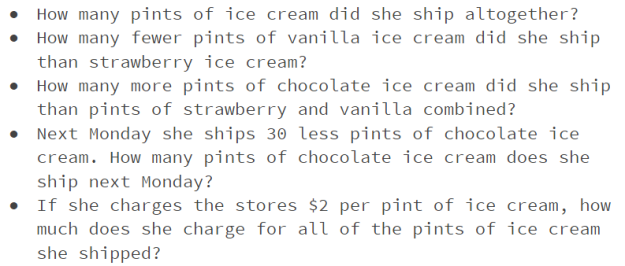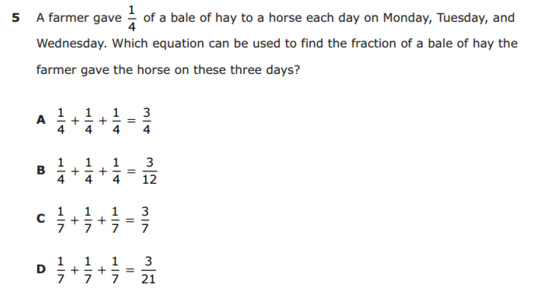Now that I’ve completed sets of numberless word problems for all of the addition and subtraction CGI problem types, I wanted to do something fun.
This school year, my co-worker Regina Payne and I have been visiting the teachers in our Math Rocks cohort. One of the things they’ve been graciously letting us do is model how to facilitate a numberless word problems. In addition to making this a learning experience for the teachers, we’ve made it a learning experience for ourselves by putting a twist on the numberless word problem format.
Instead of your usual wordy word problem, we’ve been trying out problems that include visuals, specifically graphs. Instead of revealing numbers one at a time, we’ve been revealing parts of the graph. Let me walk you through an example I made tonight.
Here’s the graph I started with. I created it with some data I found on the Internet.

If I threw this graph at a 4th or 5th grader along with a word problem, they would probably ignore what the graph is all about and just focus on getting the numbers they need for doing whatever computations they’ve decided to do. They would probably also ignore a vital piece of information – the scale that says “In Millions” – which means their answer is going to be about 1,000,000 times too small.
But what if we could change that by starting with something a little more accessible like this?

What do you notice? What do you wonder?
I’m guessing at least one student in the class would comment that it looks like a bar graph. Interesting. What do you think this bar graph could represent?
Oh, and you think a bar is missing in the middle. Interesting. What makes you say that?

What new information was added to the graph? How does it change your thinking?
Oh, so there is a bar between Hershey’s and M&M’s. How tall do you think the bar for Snickers might be? Why do you say that?

Now we know how tall the bar for Snickers is. How does that compare to our predictions?
Considering everything we know so far, what do you think this bar graph is about? What other information do we need in order to get the full story of this graph?

What new information was added to the graph? How does it change your thinking about what this graph is about?
What are Sales? How do they relate to candy?
What does “In Millions” mean? How does that relate to Sales?
I know we don’t have any numbers yet, but what relationships do you see in the graph? What comparisons can you make?

What new information was added? How does it change your thinking?
Hmm, how many dollars in sales do you think each bar represents? How did you decide?

How do the actual numbers compare to your estimates?
What were the total sales for Reese’s in 2013? (I’d sneak in this question if I felt like the students needed a reminder about the scale being in millions.)
What are some other questions you could use answer using the data in this bar graph?

What is this question asking?
How can you use the information in the graph to help you answer this question?
*****
I may or may not actually show that last slide. After reading this blog post by one of our instructional coaches Leilani Losli, I like the idea of letting the students generate and answer their own questions. In addition to being motivating for the students, it makes my time creating the graph well spent. I don’t want to spend a lot of time digging up data, making a graph, and then asking my students a whopping one question about it! That doesn’t motivate me to make more graphs. I also want students to recognize that we can ask lots of different questions to make sense of data to better understand the story its telling.
Some thoughts before I close. This takes longer than your typical numberless word problem. There are a lot more reveals. Don’t be surprised if this takes you at least 15-20 minutes when you take into account all of the discussion. When I first do a graphing problem like this with a class, it’s worth the time. I like the extra scaffolding. Kids without a lot of sense making practice tend to be pretty terrible about paying attention to details in graphs, especially if their focus is on solving an accompanying word problem.
If I were to use this type of problem more frequently with a group of students, I could probably start to get away with fewer and fewer reveals. Remember, the numberless word problem routine is a scaffold not a crutch. My hope is that over time the students will develop good habits for attending to features and data in graphs on their own. If you’re looking for a transition to scaffold away from numberless and toward independence, you might start by showing the full graph and then have students notice and wonder about it before revealing the accompanying word problem.
If you’d like to try out this problem, here’s a link to a slideshow with all of the graph reveals. You’ll notice blank slides interspersed throughout. I’ve found that if you have a clicker or mouse that has a tendency to jump ahead a slide or two, the blank slide can prevent accidental reveals. It also helps with graphs because when I snip the pictures in they aren’t always exactly the same size. If the blank slides weren’t there, you’d probably notice the slight differences immediately, but clearing the screen between reveals mitigates that problem.
Happy Halloween!


















